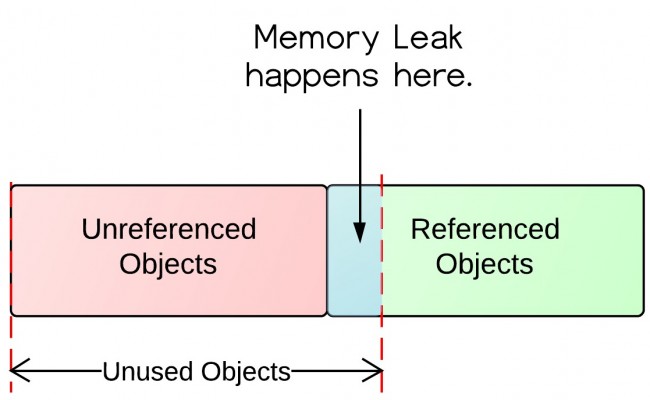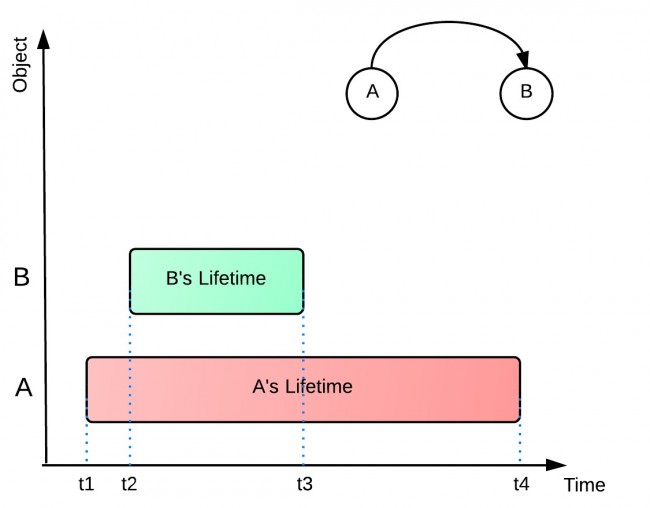The Introduction of Java Memory Leaks
One of the most significant advantages of Java is its memory management. You simply create objects and Java Garbage Collector takes care of allocating and freeing memory. However, the situation is not as simple as that, because memory leaks frequently occur in Java applications.
This tutorial illustrates what is memory leak, why it happens, and how to prevent them.
1. What is Memory Leak?
Definition of Memory Leak: objects are no longer being used by the application, but Garbage Collector can not remove them because they are being referenced.
To understand this definition, we need to understand objects status in memory. The following diagram illustrates what is unused and what is unreferenced.

From the diagram, there are referenced objects and unreferenced objects. Unreferenced objects will be garbage collected, while referenced objects will not be garbage collected. Unreferenced objects are surely unused, because no other objects refer to it. However, unused objects are not all unreferenced. Some of them are being referenced! That's where the memory leaks come from.
2. Why Memory Leaks Happen?
Let's take a look at the following example and see why memory leaks happen. In the example below, object A refers to object B. A's lifetime (t1 - t4) is much longer than B's (t2 - t3). When B is no longer being used in the application, A still holds a reference to it. In this way, Garbage Collector can not remove B from memory. This would possibly cause out of memory problem, because if A does the same thing for more objects, then there would be a lot of objects that are uncollected and consume memory space.
It is also possible that B hold a bunch of references of other objects. Those objects referenced by B will not get collected either. All those unused objects will consume precious memory space.

3. How to Prevent Memory Leaks?
The following are some quick hands-on tips for preventing memory leaks.
- Pay attention to Collection classes, such as HashMap, ArrayList, etc., as they are common places to find memory leaks. When they are declared
static, their life time is the same as the life time of the application. - Pay attention to event listeners and callbacks. A memory leak may occur if a listener is registered but not unregistered when the class is not being used any longer.
- "If a class manages its own memory, the programer should be alert for memory leaks."[1] Often times member variables of an object that point to other objects need to be null out.
4. A little Quiz: Why substring() method in JDK 6 can cause memory leaks?
To answer this question, you may want to read Substring() in JDK 6 and 7.
References:
[1] Bloch, Joshua. Effective java. Addison-Wesley Professional, 2008.
[2] IBM Developer Work. http://www.ibm.com/developerworks/library/j-leaks/
The Introduction of Java Memory Leaks的更多相关文章
- Find out when memory leaks are a concern and how to prevent them
Handling memory leaks in Java programs Find out when memory leaks are a concern and how to prevent t ...
- On Memory Leaks in Java and in Android.
from:http://chaosinmotion.com/blog/?p=696 Just because it's a garbage collected language doesn't mea ...
- Diagnosing out of memory errors and memory leaks 内存泄露实例 C Java JavaScript 内存泄露
小结: 1. 数据库连接池. JDBC语句和结果对象必须显式地关闭. 2. 电梯到目标楼层后地址是否被释放 When a button is pressed: Get some memory, whi ...
- Debugging Java Native Memory Leaks
GZIP造成JAVA Native Memory泄漏案例 https://www.elastic.co/blog/tracking-down-native-memory-leaks-in-elasti ...
- Java Memory Management(1)
Java Memory Management, with its built-in garbage collection, is one of the language’s finest achiev ...
- 内存泄露 Memory Leaks
什么是内存泄露 内存管理一直是Java 所鼓吹的强大优点.开发者只需要简单地创建对象,而Java的垃圾收集器将会自动管理内存空间的分配和释放. 但在很多情况下,事情并不那么简单,在 Java程序中总是 ...
- Activitys, Threads, & Memory Leaks
Activitys, Threads, & Memory Leaks 在Android编程中,一个公认的难题是在Activity的生命周期如何协调长期运行的任务和避免有可能出现的内存泄漏问题. ...
- Is there a way to avoid undeployment memory leaks in Tomcat?
tomcat 项目部署问题 - yshy - 博客园http://www.cnblogs.com/yshyee/p/3973293.html jsp - tomcat - their classes ...
- 内存泄漏 Memory Leaks 内存优化 MD
Markdown版本笔记 我的GitHub首页 我的博客 我的微信 我的邮箱 MyAndroidBlogs baiqiantao baiqiantao bqt20094 baiqiantao@sina ...
随机推荐
- Super Object Toolkit (支持排序)
(* * Super Object Toolkit * * Usage allowed under the restrictions of the Lesser GNU General Public ...
- google查询技巧
技巧一:使用正确的方法 无论你是使用一个简单或是高级的Google搜索,在此都存在你应该使用的某种可靠的方法.遵循适当的方法你就能获得非常准确的结果:要是忽略这条建议的话,你也许就会看到大量不相关的结 ...
- Python的类实例方法,类方法,类静态方法
以下面的类定义为例: # coding:utf-8 class A: count = 0 def __init__(self, inst_name): self.inst_name = inst_na ...
- SQL2012 附加数据库提示5120错误解决方法
在win8.1 x64系统上使用sql2012进行附加数据库(包括在x86系统正在使用的数据库文件,直接拷贝附加在X64系统中)时,提示无法打开文件,5120错误. 这个错误是因为没有操作权限,所以附 ...
- mdelay,udelay,msleep区别
delay函数是忙则等待,占用CPU时间:而sleep函数使调用的进程进行休眠. udelay引用头文件/include/asm-***/delay.h,mdelay和ndelay则引用/includ ...
- 从零开始学ios开发(十六):Navigation Controllers and Table Views(下)
终于进行到下了,这是关于Navigation Controllers和Table Views的最后一个例子,稍微复杂了一点,但也仅仅是复杂而已,难度不大,我们开始吧. 如果没有上一篇的代码,可以从这里 ...
- c 标签
1 . c:out -- Like <%= ... >, but for expressions. =out.println(String) <c:out value=" ...
- eclipse的android智能提示设置
eclipse的android智能提示设置 分类: android 技术2011-12-07 23:13 3069人阅读 评论(0) 收藏 举报 eclipseandroidtriggersjavaf ...
- java集合类(六)About Queue
接上篇“java集合类(五)About Map” 终于来到了java集合类的尾声,太兴奋了,不是因为可以休息一阵了,而是因为又到了开启新知识的时刻,大家一起加油打气!!Come on...Fighti ...
- angular-file-upload API angular文件上传插件
官方例子 : http://nervgh.github.io/pages/angular-file-upload/examples/simple/ ===Directives=== nvFileSel ...
